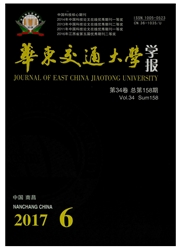

 中文摘要:
中文摘要:
为了减少车辆在城市道路系统中的能源消耗,从降低信号交叉口能耗的角度出发,对交叉口进行基于累积能耗的优化配时方法研究。在累积延误分析的基础上研究机动车怠速能耗、减速能耗和加速能耗的规律,由此推导出信号交叉口累积能耗模型,在该模型的基础上建立基于累积能耗与延误综合指标最小的交叉口信号配时优化模型。利用实际交叉口的vis-sim仿真,对比分析现状配时、韦伯斯特法配时和基于累积能耗方法配时的交叉口累积能耗和延误,结果表明,基于累积能耗的优化配时方法可以有效降低累积能耗和延误。
 英文摘要:
英文摘要:
In order to reduce the energy consumption of vehicles in urban road systems, this study discusses the timing method optimization based on cumulative energy consumption of signal intersections from the perspective of energy consumption reduction. Based on the cumulative delay, it explores the rules for idling, deceleration and acceleration energy consumption of the motor vehicles, thus obtaining the cumulative energy consumption model of signal intersections. Then the optimized timing model is established based on the minimum comprehensive in-dex of the cumulative energy and delay. Through vissim simulation of the actual intersection and the comparative analysis of the cumulative energy consumption and delay derived from the current timing method, Webster timing method and cumulative energy timing method, it finds out that the optimized timing method based on cumulative energy consumption can effectively reduce the cumulative energy consumption and delay.
 同期刊论文项目
同期刊论文项目
 同项目期刊论文
同项目期刊论文
 期刊信息
期刊信息
